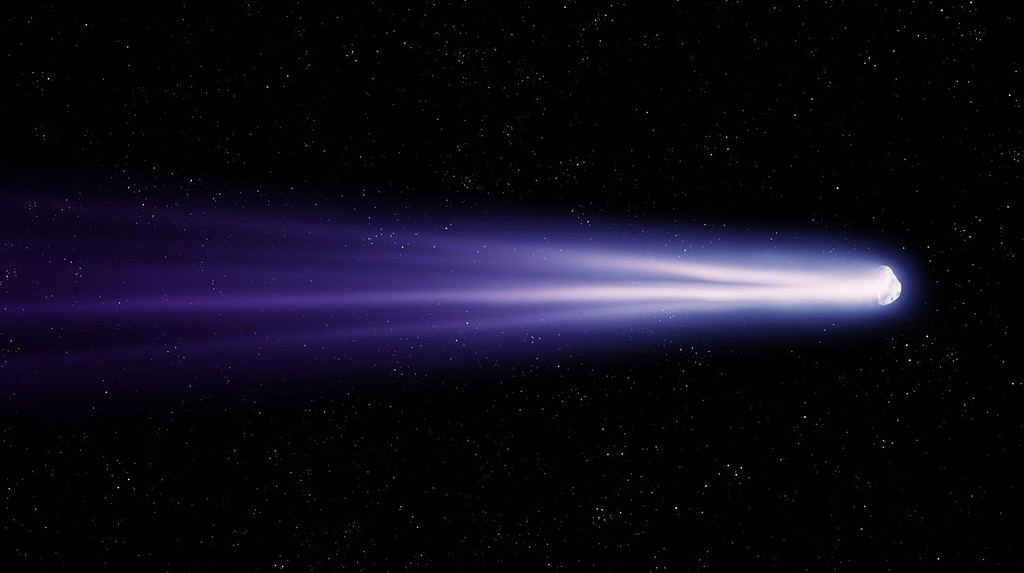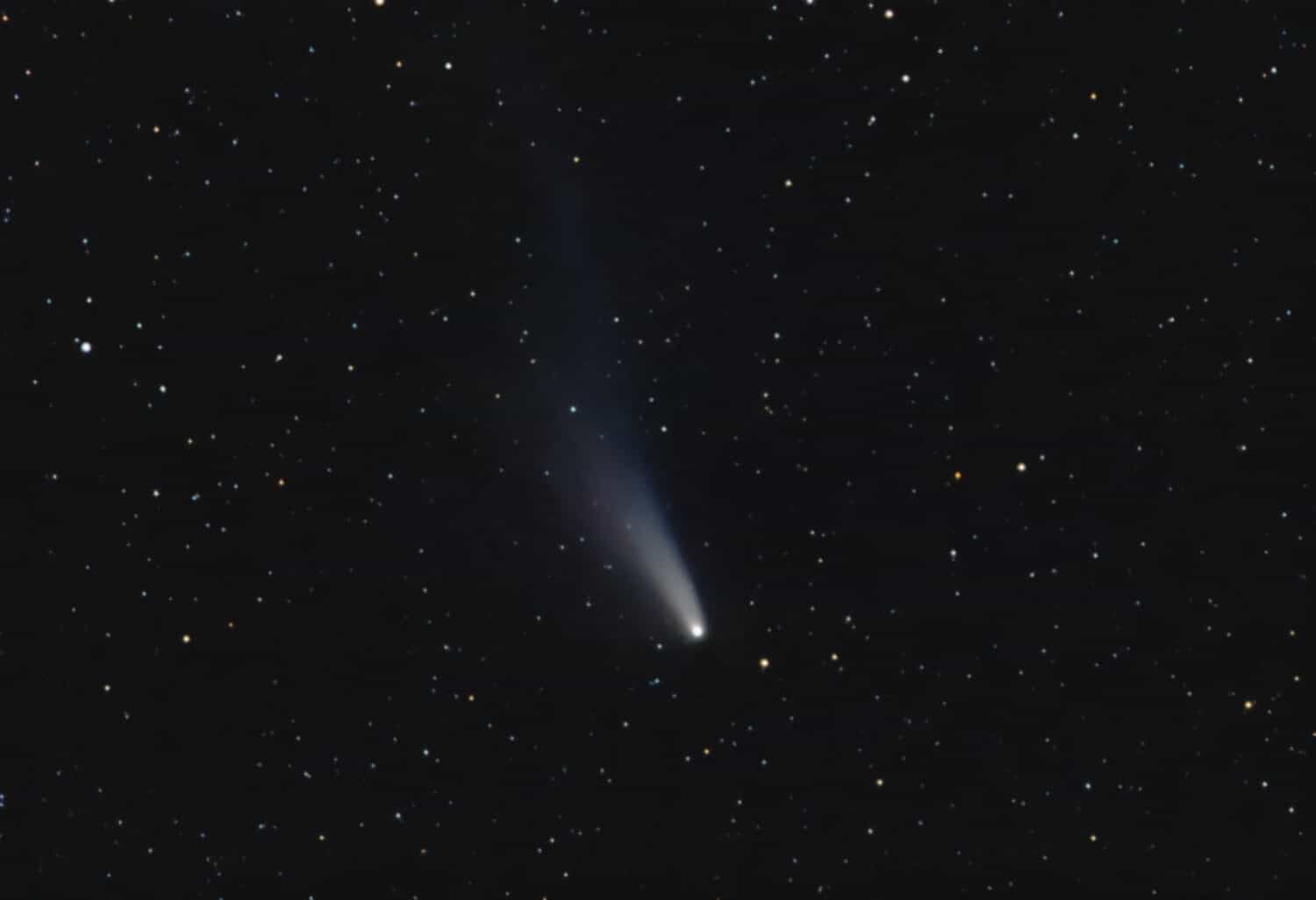Halley’s Comet is the most well-known comet in history because it returns regularly to the inner solar system every 75-79 years and is visible to the naked eye from Earth. It’s the only visible comet that can appear twice within a human lifetime. Famously, Mark Twain was born when it appeared in 1835 and died when it returned in 1910. The last time it passed was 1986, and if you’re around in 2061, you’ll get to see it for yourself!

Halley’s comet last appeared in 1986 and will return again in 2061.
©Brian Donovan/Shutterstock.com
What are Comets?
Comets are frozen balls of water, carbon dioxide, ammonia, and dust. Halley’s Comet is about nine miles long and five miles wide. Many thousands of comets orbit in a region called the Oort Cloud, far beyond the orbits of even the outermost planets of our solar system. Halley’s Comet is a periodic or short-term comet, which means it has an orbit that takes 200 years or less. There are about 75 comets of the same type as Halley’s. Long-period comets, by contrast, can take thousands of years to complete one trip around the sun.
As a comet gets closer to the sun in its orbit, solar radiation begins to vaporize the frozen elements into particles that escape from the comet nucleus and stream out behind the comet in a tail stretching hundreds of thousands up to millions of miles. Some researchers speculate that collisions with comets may have brought water and other elements essential to life to Earth.

Some researchers speculate that collisions with comets may have brought water and other elements essential to life to Earth.
©Triff/Shutterstock.com
Halley’s Comet in Human History
People have been confirming sightings of Halley’s Comet since 240 B.C. Ancient Chinese, Babylonian, Armenian, Indian, and Roman astronomers all described its appearances. Ancient people often saw it as a divine portent of the rise or fall of empires or the birth or death of significant people. For example, Romans associated it with the death of Marcus Vipsanius Agrippa the same year it appeared. Some have suggested it has a connection to the Star of Bethlehem that the Bible describes as appearing at the time Jesus Christ was born. One of the most striking coincidences in a visit of Halley’s Comet happened in 1066 when it appeared over England a year before King Harold II died at the Battle of Hastings and William the Conqueror claimed the throne. The famous Bayeux Tapestry depicts this event.
Throughout this whole time, most people thought these appearances were all different comets. After conferring with Isaac Newton on his laws of motion, 18th-century astronomer Edmond Halley became the first to realize that the same comet was returning again and again. This is why the comet was named after him. The 1835 and 1910 visits by the comet were bookends to the life of Mark Twain, who was born and died in those years. In 1910 the comet was especially spectacular as viewed from Earth, and in fact, the planet passed through the tail of the comet, sparking a booming business in gas mask sales to a panicked public. In the end, it had no discernable ill effect on the planet.
The 1986 return of Halley’s Comet taught us more about it than all previous appearances combined. By then we were a space-faring civilization and were able to observe the comet not only from the most powerful ground-based telescopes ever built but from spacecraft as well. The European Union, the United States, Japan, and Russia all launched missions that photographed and analyzed the comet, mainly confirming many previous hypotheses about its chemical composition and behavior.

In 1910, Earth passed through the tail of Halley’s Comet, with no discernable ill effects.
©Nazarii_Neshcherenskyi/Shutterstock.com
Comets You Might See Before Halley’s
If you don’t want to wait until 2061, you might have a chance to see one of the comets below with the naked eye or with a small telescope or binoculars. The brightness of comets is unpredictable, though, and it’s always possible a new long-period comet will appear that we didn’t previously know about. These are the best candidates for viewing in the coming years:
- January 2024: 144P/Kushida
- January 2024: 62P/Tsuchinshan
- March 2024: Comet 12P/Pons-Brooks
- June 2024: Comet 13P/Olbers
- January 2031: Comet Bernardinelli-Bernstein C/2014 UN271
Can You Discover a Comet?
You don’t necessarily have to wait for Halley’s Comet or another known comet to appear. Amateur astronomers discover new ones all the time, armed only with binoculars or a small telescope of 20-40x magnification. Here are some tips to help you find your own comet:
- Find a dark place to observe, far from the light pollution of cities and at a high elevation if possible.
- Research and learn to distinguish between a comet and other deep sky objects that may look similar.
- The best direction to look is east and the best time is 20-30 minutes before sunrise or after sunset. At this time the comet’s tail will be most visible as seen from Earth.
- Sweep the horizon slowly, looking for a small fuzzy smudge.
- Be supremely patient. Discovering a comet can take hundreds of hours of observation.
Finding a comet is like finding a needle in a haystack; maybe even harder. But if you do, there’s a good chance it will be named after you. And hundreds of years in the future when someone is writing an article like this one about it, you will be part of that story!
Thank you for reading! Have some feedback for us? Contact the AZ Animals editorial team.








